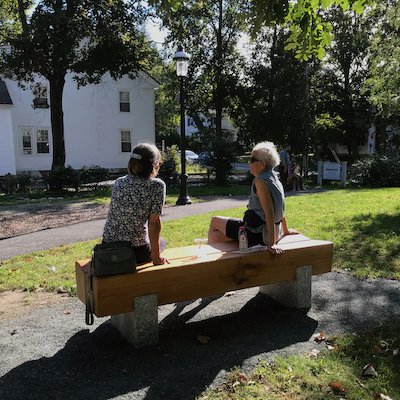
Sustainable Landscaping
Promoting a Healthy Environment for All Through Landscaping
What is Sustainable Landscaping?
Sustainable landscaping pertains specifically to those natural spaces closest to us where we interact most directly with nature and have the opportunity to have an impact. It is a direct and satisfying way to make a difference on a daily basis for the climate, the earth, our community and ourselves.
For the beginner, sustainable landscaping in its most basic form means ‘doing no harm’ by not adding toxic substances and by limiting water use in and around our homes.
For those committed to doing more, sustainable landscaping means avoiding toxic additions, conserving limited resources such as water and energy and reducing waste and water runoff in order to prevent air, water and soil pollution. It involves preserving existing and native plants, removing invasive species, and using trees and other vegetation to cut energy consumption. It values the soil and composting. It embraces integrated pest management and non-fossil fuel landscape maintenance tools (Wikipedia, Landscaping Network, Landscape East & West).
For the inspired, sustainable landscaping is regenerative, actively contributing to the development of healthy communities. It sequesters carbon, cleans the air and water, increases energy efficiency, restores habitats, supports healthy ecosystems, and creates value through significant economic, social and environmental benefits (ASLA).
Why Sustainable Landscaping?
Sustainable landscaping supports healthy ecosystems and builds resilience against increasingly unpredictable and extreme weather, especially strong rains and prolonged droughts.
Planting a more diverse palette of trees, shrubs, vegetables, perennials and grasses helps sequester carbon.
Carefully selecting plants contributes to the biodiversity of one’s entire community and creates food corridors for migratory birds, butterflies and other creatures.
Thoughtfully managing water on one’s own properties -- for example, rain barrels to help capture runoff for use during dry spells and rain gardens to retain and treat runoff before it enters the stormwater system -- supports healthy watersheds.
Appropriately handling leaves, yard waste and food compost enhances soil health.
Eliminating the use of gasoline powered landscaping equipment such as lawn mowers and leaf blowers decreases fossil fuel consumption as well as air and noise pollution.
Finally, did you know that Americans spend more than $36 billion every year on lawn care, four and a half times more than the annual budget for the Environmental Protection Agency? When we shift from lawns to sustainable landscaping, we can also save money! (GRIST Magazine)
Best of all, Sustainable Landscaping Promotes Well-Being
In caring for plants and animals, we are, in fact, also caring for ourselves. Numerous studies show that interacting with soil and plants reduces stress, is good for our hearts, builds hand strength and makes us feel better about ourselves (American Psychological Association). By planting a tomato plant in a pot on our deck or a blueberry shrub by our front door or creating a small oasis for pollinators, we are promoting connections between ourselves and the natural world. Participating in a community garden or a community landscaping project also cultivates valuable social connections, something COVID showed us we can’t do without.
Ready to Start?
-

Visit Hanover's Sustainability Park at School Street
To see examples of native and other hearty plants you might include in your home landscape, check out Hanover’s Sustainability Park at 6 School Street (link). When there, take a look at the gardening books in the Little Free Gardening Library! Better yet, if you have gardening books you’d like to share, feel free to donate them!
-

Nurture Land & Soil
Nurture land and soil by recycling and reducing all waste, composting, monitoring invasive species (Hanover Biodiversity Committee), assessing how you care for water, and rethinking lawn care strategies.
-

Visit Local Nurseries & Garden Centers
A great way to learn about native and resilient perennials, shrubs and trees is to visit local nurseries and garden centers. Be sure to look for and ask about pesticide free, regionally grown plants. Bring your reading glasses (if you need them) so you can read the labels!
-

Join a Local Garden Group
Sustainable Landscaping is an ongoing adventure that can be as simple or complex as you wish. Consider participating in a Hanover Garden Club workshop or joining the gardening group on NextDoor (You’ll need to join Next Door to participate).
-

Create New Habitat
Create habitat for all, whether in an elevated planter on a balcony, a mixed shrub border or a vegetable and/or perennial garden next to one’s deck. Sustainable landscaping also invites property owners to transition all or part of their lawns to plants that cultivate biodiversity.
-

Join a National Initiative
Commit to make a difference by joining a national initiative. The Xerxes Society has a pollinator protection pledge and Ecochallenge.org hosts multiple challenges throughout the year. If there are other initiatives that inspire you, please let us know and we can build a resource list that supports building a sustainable future.

Did it? Celebrate!
Congratulations on Supporting Sustainable Landscaping in Hanover!
You are now part of our growing community of people cultivating a thriving environment for all.
Here are some suggestions for next steps:



